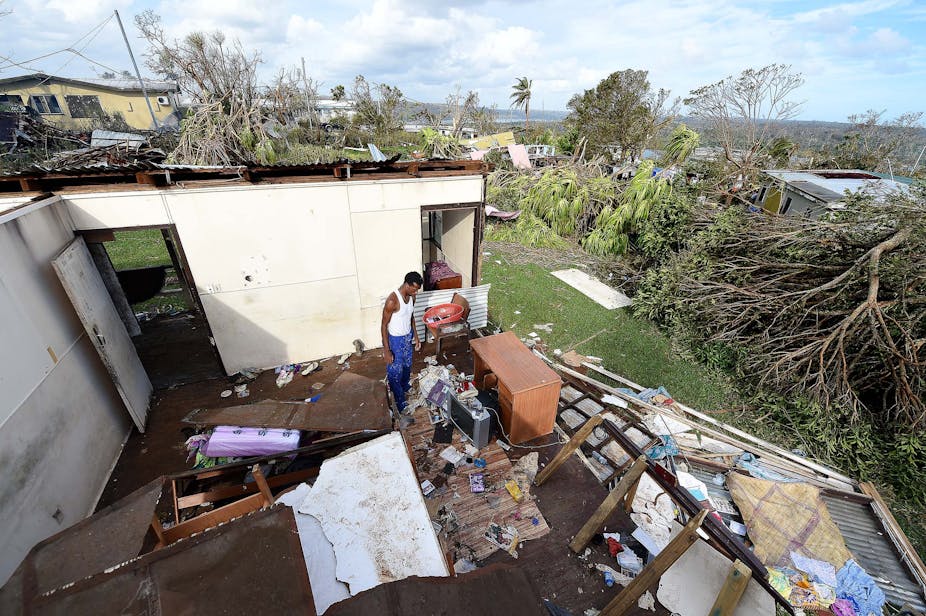Severe tropical Cyclone Pam, which devastated Vanuatu on Saturday, was one of the most intense tropical storms on record and is reported to have caused widespread damage to public infrastructure and housing, with sustained winds of around 250 kilometres an hour near the centre.
The latest estimates suggest that up to 24 people have died. The damage and casualties in outlying areas of Vanuatu are yet to be properly assessed.
The President of Vanuatu, Baldwin Lonsdale, indicates that more than 90% of the buildings and houses in the capital Port Vila have been destroyed or damaged.
The destruction caused by Cyclone Pam is clearly a humanitarian tragedy that will set back development in this small island nation and strain the capacities of government agencies seeking to respond.
We argue that the Pacific needs a “climate insurance scheme” to help fund recovery after these tragic events.
Uncertain future
Whenever an extreme weather event such as Cyclone Pam occurs arguments break out about whether human induced climate change is to blame. Vanuatu President Lonsdale reportedly claimed a link between human induced climate change and Cyclone Pam.
However, the complexity of the physical systems that underlie climate patterns and weather events means that it is not possible for scientists to state that any single event was “caused” by climate change.
Rather, the probability of such intense events occurring is likely to increase due to the effects of climate change.
The Intergovernmental Panel on Climate Change (IPCC) Fifth Assessment Report points out (with high confidence) that tropical cyclones are one of the current and future climate-related drivers of risk for small islands through the 21st Century.
However, there can be no argument about the huge strain placed on the governments of small Pacific island states to respond to the needs of their people in the weeks and months that follow a large tropical cyclone.
In this period, governments of these small island states are largely at the mercy of aid donations from developed countries and assistance provided by the United Nations. While this assistance is greatly appreciated, it is short term and uncertain. This makes it difficult for governments to plan for and respond to these events.
At the same time, the tax revenue that governments usually receive from the tourism and agricultural sectors typically falls away. This can have a crippling effect on these small Pacific Island states in both the shorter and longer terms.
Insuring against island disasters
Some small island nations have tried to take matters into their own hands.
In 2007 thirteen small island nations of the Caribbean region formed the Caribbean Catastrophe Risk Insurance Facility (CCRIF). The CCRIF is a regional risk pooling institution that allows individual member countries to take out insurance cover against damage caused by events such as hurricane, earthquake and extreme rainfall.
The member countries take out yearly insurance with the facility to provide property damage insurance to cover losses up to US$100 million. The facility takes out reinsurance on the international reinsurance markets at a better rate than can be obtained by individual countries acting alone.
The insurance is based on a “parametric trigger”, for instance, a nominated wind speed. As long as the wind speed of a particular cyclone exceeds this parametric trigger the insurance will operate and provide monies to the government that might be spent on disaster relief and rebuilding damaged infrastructure.
There is no need for a country to show that climate change was a cause of the cyclone or extreme precipitation event.
The other important feature of the CCRIF is that the amount paid out to countries under the insurance is pre-determined by modelling of damage caused by similar earlier events. This means that there is no need for an assessment of damage after the event to determine the extent of loss and the amount to be paid out.
The strength of the cyclone and loss modelling attached to the insurance provide a payout figure that can be paid within weeks after the event occurs, when it is needed the most. Since the CCRIF was formed in 2007, the facility has paid out twelve claims for hurricanes, earthquakes and excess rainfall totalling approximately US$35.6 million to eight member states.
All were made to the respective governments within 14 days of the event, the largest being in 2010 to Barbados after tropical cyclone Tomas.
A scheme for the Pacific
A similar scheme is urgently required for the Pacific region to assist countries like Vanuatu to cope with the immediate aftermath of events such as Cyclone Pam.
The Asian Development Bank has recently piloted such a scheme that deserves developed country support and further expansion. Vanuatu are currently participating in this pilot project, and may be entitled to a payout relating to Cyclone Pam.
However, this pilot project will come to an end later this year. The Pacific region requires a wider and more permanent institution to provide this support for all Pacific Island nations into the future.
Developed countries such as Japan and Ireland, and organisations such as the World Bank were central in providing the initial funding and impetus to set up the CCRIF.
The developed countries of the Pacific region such as Australia, New Zealand and the United States should look closely at supporting a similar risk pooling mechanism to assist countries like Vanuatu that face the ongoing risk of these powerful cyclones.
Such a mechanism may enhance the resilience of our Pacific Island neighbours into the future.
This article was co-authored by Joseph Wenta, a former associate lecturer at the University of Newcastle. Jeff McGee, Liam Phelan and Joseph Wenta recently published an article on climate insurance in the Melbourne Journal of International Law.

